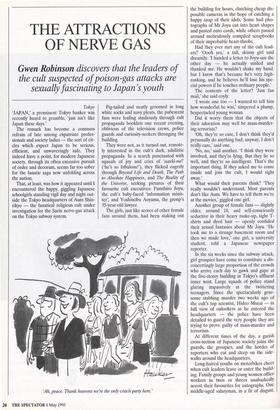THE ATTRACTIONS OF NERVE GAS
Gwen Robinson discovers that the leaders of
the cult suspected of poison-gas attacks are sexually fascinating to Japan's youth
Tokyo `JAPAN,' a prominent Tokyo banker was recently heard to grumble, 'just isn't like Japan these days.'
The remark has become a common refrain of late among expatriate profes- sionals and society ladies — the sort of cir- cles which expect Japan to be serious, efficient, and unwaveringly safe. They indeed have a point, for modern Japanese society, through its often excessive pursuit of order and decorum, seems far too sober for the lunatic saga now unfolding across the nation.
That, at least, was how it appeared until I encountered the happy, giggling Japanese schoolgirls standing vigil day and night out- side the Tokyo headquarters of Aum Shin- rikyo — the fanatical religious cult under investigation for the Sarin nerve-gas attack on the Tokyo subway system. Pig-tailed and neatly groomed in long white socks and navy pleats, the pubescent fans were leafing studiously through cult propaganda booklets one recent evening, oblivious of the television crews, police guards and curiosity-seekers thronging the building.
They were not, as it turned out, remote- ly interested in the cult's dark, nihilistic propaganda. In a search punctuated with squeals of joy and cries of `suteki-na!' (`he's so fabulous!'), they flicked eagerly through Beyond Life and Death, The Path to Absolute Happiness, and The Reality of the Universe, seeking pictures of their favourite cult executives: Fumihiro Joyu, the cult's baby-faced 'information minis- ter', and Yoshinobu Aoyama, the group's 35-year-old lawyer.
The girls, just like scores of other female fans around them, had been staking out Ah, peace. Thank heavens we're the only coach party here.' the building for hours, clutching cheap dis- posable cameras in the hope of catching a happy snap of their idols. Some had pho- tographs of Mr Joyu cut into heart shapes and pasted onto cards, while others passed around meticulously compiled scrapbooks of their improbable heart-throbs.
Had they ever met any of the cult lead- ers? 'Oooh yes,' a tall, skinny girl said dreamily. 'I handed a letter to Joyu-san the other day — he actually smiled and thanked me. He wouldn't shake my hand, but I know that's because he's very high- ranking, and he believes he'll lose his spe- cial powers if he touches ordinary people.'
The contents of the letter? 'Just fan mail,' she said coyly.
`I wrote one too — I wanted to tell him how wonderful he was,' simpered a plump, bespectacled young woman.
Did it worry them that the objects of their adoration may well be mass-murder- ing terrorists?
`Oh, they're so cute, I don't think they'd personally do anything bad; anyway, I don't really care,' said one.
No, no,' said another. 'I think they were involved, and they're lying. But they lie so well, and they're so intelligent. That's the important thing. If they asked me to come inside and join the cult, I would right away.'
What would their parents think? 'They really wouldn't understand. Most parents don't like Aum. We have to tell them we're at the movies,' giggled one girl.
Another group of female fans — slightly older, around 18, and self-consciously seductive in their heavy make-up, tight T- shirts and dyed hair — openly confided their sexual fantasies about Mr Joyu. 'He took me to a strange basement room and then we made love,' one girl, a university student, told a Japanese newspaper reporter.
In the six weeks since the subway attack, girl groupies have come to constitute a dis- concertingly large proportion of the crowds who arrive each day to gawk and gape at the five-storey building in Tokyo's affluent inner west. Large squads of police stand glaring impassively at the twittering teenagers. Since the spectacularly grue some stabbing murder two weeks ago of the cult's top scientist, Hideo Murai — in full view of onlookers as he entered the headquarters — the police have been detailed to guard the very people they are trying to prove guilty of mass-murder and terrorism.
At different times of the day, a garish cross-section of Japanese society joins the guards, the groupies, and the hordes of reporters who eat and sleep on the side- walks around the headquarters. Long-haired youths on motorbikes cheer when cult leaders leave or enter the build- ing. Family groups and young women office workers in twos or threes unabashedly accost their favourites for autographs. One middle-aged salaryman, in a fit of disgust, began urinating last week on the front door before he was ushered away — mid- stream — by policemen.
Civil rights campaigners, meanwhile, have added their own incongruous touch by staging drum-banging demonstrations outside the premises to protest against `police violations' of the cult's human rights. These and other absurdities have created a carnival atmosphere around the headquarters which is as chilling as it is ridiculous.
Frenzied media coverage, while cata- pulting the handsome cult spokesmen to celebrity status, has effectively painted the organisation as an evil, psychotic force, far beyond the direst villain of the horror movies which are so popular here. There have been accounts of how cult members drink blood, inject their children with drugs, and wear electronically wired `happy hats' which send small shocks through their bodies.
Newspapers have purported to reveal how the cult had more than 300 scientists and researchers working on biological, chemical and even nuclear weapons; how former gangsters were training hit squads with KGB manuals and procuring guns; and how would-be defectors were cap- tured, confined and abused. There have even been revelations of how the cult infil- trated sensitive units of the military, the police, and influential industries.
The cult leaders are suspected not only of arranging the subway attack, which killed 12 and injured more than 5,500 peo- ple, but also of masterminding a range of other crimes — from the attempted assas- sination of Japan's police chief to kidnap- ping, murder, extortion and illicit trafficking in weapons and drugs.
Japanese and foreign media commenta- tors, in their endless theorising about what it all means, have bemoaned the 'loss of innocence' in a formerly safe society. Soci- ologists have trotted out theories about the harmful impact of mass terrorism on the collective psyche.
But the grotesque displays of teenage adoration, which surely pose one of the most striking questions of the whole affair, appear to have been overlooked: how, amid such hysteria, has a group which ranks as the most feared and hated organi- sation in Japan spawned one of the coun- try's hottest sex symbols? Slender, boyishly handsome and highly articulate, Mr Joyu looks like a Japanese version of Brad Pitt. Clad in his habitual shocking turquoise pyjamas (standard issue for the cult's top 'monks% he could pass for one of Issey Miyake's star models. Mr Joyu's media skills, however, are more to be compared with those of Josef Goebbels. To those who listen carefully to his quasi-Buddhist speak and endless stream of glib explanations, he exudes a distinctly sinister quality. He and his cohorts spearhead a sophisti- cated propaganda machine which has blitzed every national television network and major publication since the subway attack on 20 March. Not a politician or film star in the country could claim more live airtime in the past six weeks than the boys from Aum.
Audience ratings soar when they appear on television — a phenomenon which has been jokingly dubbed 'the Aum effect'. Secure in their celebrity-villain status, the spokesmen lay down strict terms, insisting they will only appear on live broadcasts so that interviews can't be edited.
Mr Joyu interprets his own remarks for the western press, switching between flu- ent English and Japanese. Other members of his 'Information Ministry' also display remarkable fluency in languages, including Russian and English.
In the limited circles of Japanese intelli- gentsia, Mr Joyu's impassioned claims of innocence and outlandish defences of cult activities have touched off fierce debate about the ethics of giving so much prime- time publicity to suspected murderers and terrorists. A new concern has recently taken root, that the cult, through its free and uncensored proselytising, has actually gained followers since the subway attack.
Questions of media ethics and morality, however, appear to have as little impact on the popular press as they have on the cult's growing number of young fans. Tele- vision interviewers seem more interested in Mr Joyu's sex life than the truth of the subway attack. His most widely publicised statement (aside from 'We're innocent, we're Buddhists, we love the world') is his claim to have sacrificed earthly pleasures in order to remain celibate in the nine years since he joined the cult.
`Well, do you at least masturbate?' asked one wide-eyed television interview- er.
In an article headlined `Mr Joyu is Fan- tastic!' Shukan Josei, a weekly magazine for young women, gushed about his good `We're getting marginally less sympathy than veal exporters.' looks, eloquence, and intelligence. Other magazines have run investigative reports on whether or not his claims of celibacy are true.
During his public appearances, young girls can be seen waiting around doorways to give Mr Joyu flowers and fan letters, ask for autographs, or just gaze admiringly. On a recent occasion, when he appeared on a television talk show looking particularly pale and wan, women viewers called the station offering to send food and medicine. This is the way pop stars and television celebrities are treated in Japan. But the current display of Aum adulation has ele- vated celebrity worship to new and per- verse heights.
Japan, it should be noted, has tradition- ally displayed a fascination for rebels and villains of all kinds. A man who paid hit- men to brutally murder his wife became a national sex symbol for middle-aged housewives in the late 1980s. Japan's `celebrity cannibal', a man who murdered and ate his Dutch girlfriend in Paris in 1981, became a popular guest on talk- shows and began writing for national mag- azines upon his return from a French mental asylum.
The popular appeal of the 'romantic vil- lain,' of course, is not limited to Japan. From Europe to America and the Far East, terrorists, assassins, and mercenaries of both sexes have enjoyed brief periods of stardom. But the only logical comparison with Japan's cult groupies would be if the Oklahoma bombers had acquired female fan clubs in America.
The cult's hardcore female fans, admit- tedly, are a microscopic minority in a country of 123 million people. They run into the thousands, but not much beyond. What cannot be overlooked, however, is that the cult-crazy schoolgirls and office secretaries and the gushy magazines cater- ing to their whims represent a solid cross- section of young, middle-class Japanese womanhood.
They are not marginal crazies, but might be a guide to the values and conduct of the next generation. Some social critics use these happy-looking young women to illustrate their theories of Japan's 'shame culture' versus the West's 'guilt culture'. Rather than the Christian-inspired codes of good and evil taught in the West, Japanese are taught first and foremost to avoid bringing shame on themselves or their families. From this spring the basic tenets which have made Japan one of the most honest, secure countries in the world: a place where lost wallets are returned, nine times out of ten — untouched — to their owners, and where women can safely walk home alone at 4 a.m.
But it is also a country which is often criticised as `amoral,' politically naive', and incapable of facing up to shameful aspects of its past — particularly the excesses of the second world war. The same naivety, it could be argued, drives today's young women, who appear unable `Isn't that cute? They're playing "Coroner".' to distinguish between a run-of-the-mill pop star and a suspected mass-murderer. Japan will always be like Japan.
Gwen Robinson is Japan correspondent for the Times.




































































 Previous page
Previous page